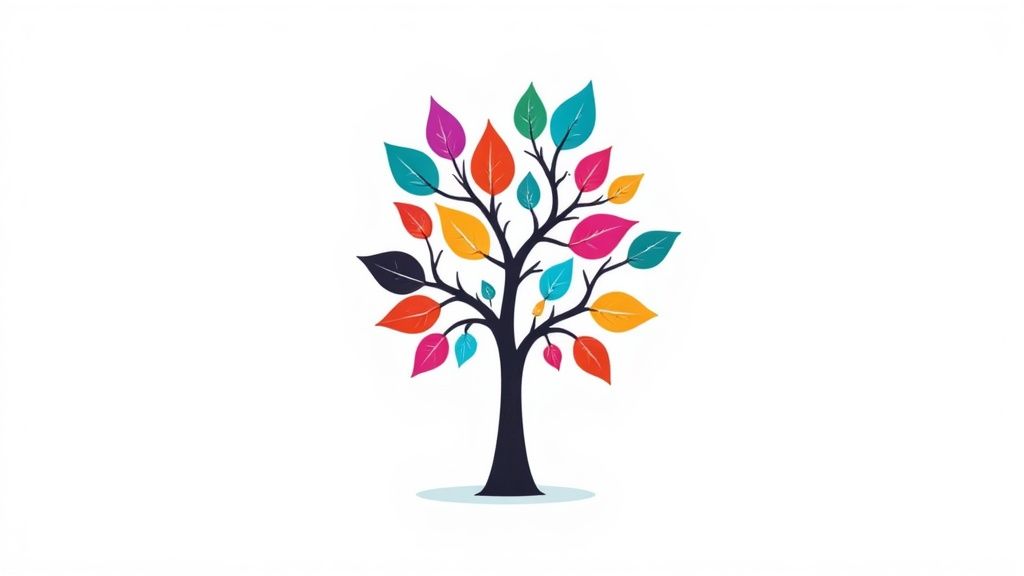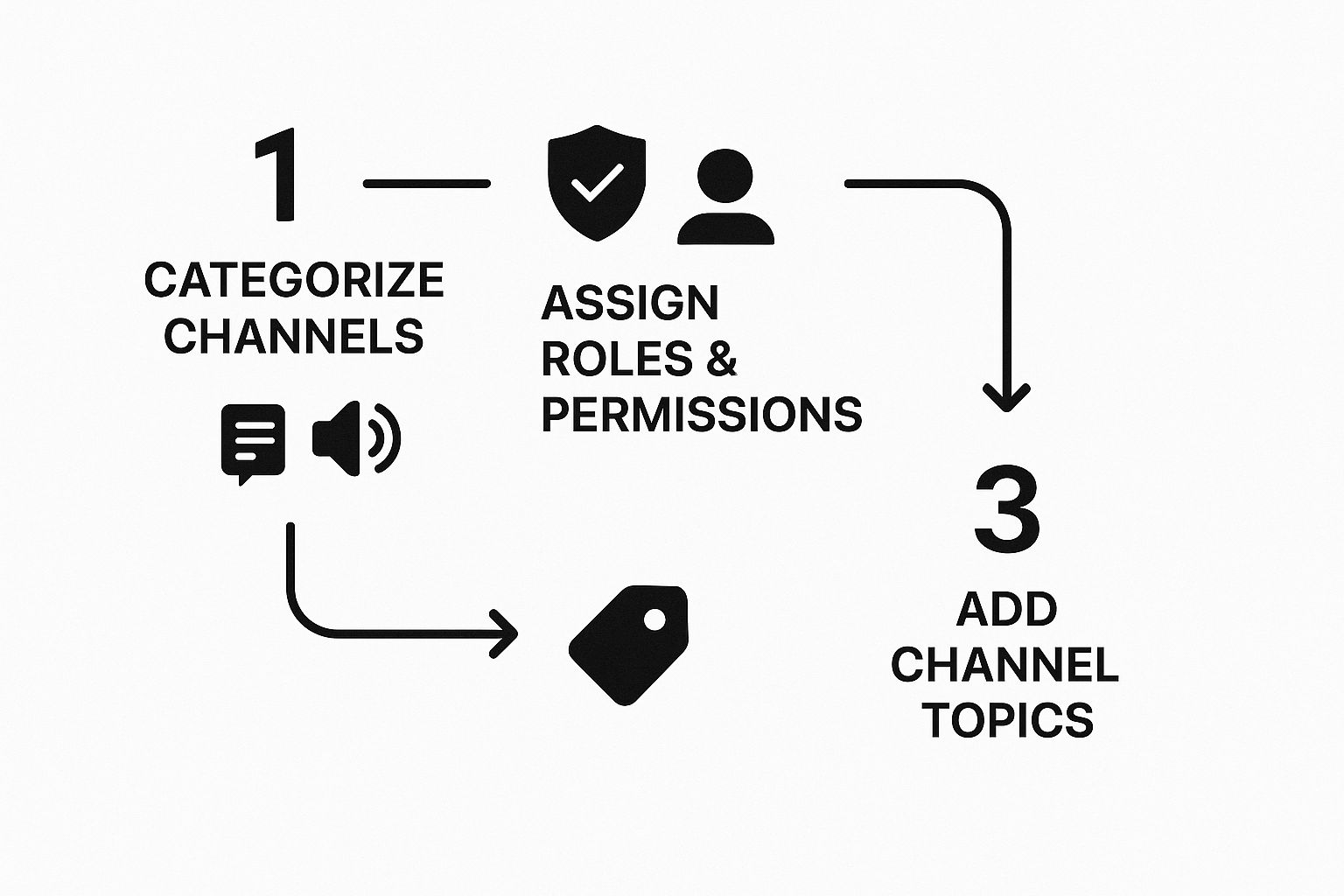A Guide to Sustainable Discord Server Growth

Lasting growth on Discord isn't about chasing huge numbers right out of the gate. It all starts with building a community that people actually want to be a part of. Before you even think about promotion, you need to create a space that feels well-designed and welcoming from the moment someone clicks "join." This is the foundation—get it wrong, and all your other efforts will fall flat.
Build a Server People Can't Wait to Join

So many server owners get this backward. They pour all their energy into advertising before their server is even ready for guests. Think of it like throwing a party—you wouldn't send out invites before you’ve cleaned the house and put out some snacks, right?
The "curb appeal" of your server is everything. A clear theme, an easy-to-navigate layout, and a friendly atmosphere are what convince a casual visitor to stick around and become a real member.
Just look at Discord's own story. It exploded from 10 million monthly users in 2016 to a projected 200 million by May 2025, mostly because it created a focused, high-quality home for communities to thrive.
Nail Down Your Server's Identity
Your server needs a soul. What’s its reason for existing? Is it a hangout for fans of a niche indie game? A workshop for budding digital artists? A think tank for crypto developers? Figuring this out is your first, most important job.
A solid identity shapes every other decision you'll make:
- Server Name & Icon: They need to be catchy, memorable, and hint at what you're all about.
- Theme & Vibe: Are you aiming for a serious, professional tone or a chaotic, meme-filled hangout? Consistency is key.
- Target Member: Who, specifically, are you trying to attract? Knowing your ideal member helps you build something they’ll love.
A server with a vague purpose appeals to no one. But a server built around a super-specific passion—say, for people who build custom mechanical keyboards from scratch—can grow a deeply engaged community all on its own. Specificity is your superpower.
While our focus is on Discord, these core ideas of attracting and keeping users are pretty universal. For a wider view, it's worth checking out these strategies for building a successful social platform to really get the fundamentals down.
Craft a Killer New Member Experience
You only get one chance to make a first impression. When someone new joins, they should instantly get a feel for the place and know what to do next. A confusing or chaotic welcome is the fastest way to get them to hit the "leave server" button.
The goal is to guide, not overwhelm.
Start with a clean #welcome channel. It should briefly explain the server's purpose and point new folks toward your rules and maybe a channel for picking roles.
Next, organize your channels into logical categories. Think in terms of "General Chat," "Project Showcase," or "Off-Topic Fun." Use clear, descriptive channel names—this isn't the place for inside jokes that new people won't get. A clean layout invites people to explore instead of making them feel lost.
Finally, set up a dedicated spot for important news. Making a great https://domino.run/blog/discord-announcement-channel is essential for keeping everyone in the loop without cluttering up your chat channels.
Turning Lurkers Into Active Members
Let's be real: a quiet server is a dead server. You can have thousands of members on your list, but if only five people are talking, it feels like a ghost town. The secret to real Discord server growth isn't just getting people through the door; it's getting them to stick around and actually participate.
This is where a little bit of smart gamification can completely change the game. Too many server owners just cross their fingers and hope for activity to magically appear. But in reality, you need to give people a reason to unmute and start typing. Turning those silent lurkers into your next regulars means being proactive and making engagement fun.
The numbers don't lie. In 2024, Discord users are sending over 4 billion messages every single day across more than 19 million active servers. That's a staggering 370% increase since 2018. The potential for a thriving community is massive, but you have to know how to tap into it.
Designing a Reward-Based Quest System
Think of a quest system as a friendly guide for your members. Instead of leaving them to wander around aimlessly, you give them clear, simple tasks that come with cool rewards. It's a classic win-win: they get a sense of accomplishment, and your server gets a jolt of activity.
The whole point is to create a positive feedback loop. A member does a thing, gets a reward, feels good about it, and then looks for the next thing to do. This can be super simple to start.
For instance, a brand-new member could be greeted with a "Welcome Adventurer!" quest board. The first few tasks could be a piece of cake:
- Icebreaker Quest: Say hi and share a fun fact in the
#introductionschannel. - Profile Quest: Add a profile picture and set a custom status.
- Reaction Quest: React to three different posts you find interesting.
Once they complete these, boom! They could automatically get a shiny new "Initiate" role that unlocks a few more channels. It’s a small victory, but it immediately makes them feel like they belong.
Quests aren't just about handing out freebies. They're about showing people the ropes, teaching them your server's culture, and rewarding them for becoming part of the fabric of the community.
This whole idea builds on having a well-organized server in the first place. You need a solid foundation before you can build a fun game on top of it.

When you have clear channels, roles, and topics, your quests can seamlessly guide members from one part of your server to the next, making the entire experience feel intuitive and rewarding.
To get your creative juices flowing, here are a few ideas for quests that encourage different types of positive behavior in your community.
High-Impact Engagement Quest Ideas
This table breaks down some quest ideas you can adapt for your own server, showing what behavior they encourage and what kind of rewards work well.
| Quest Type | Goal | Example Task | Suggested Reward |
|---|---|---|---|
| Welcome Wagon | Encourage new members to get set up and introduce themselves. | Introduce yourself in the #introductions channel. |
A "New Member" role with access to more channels. |
| Social Butterfly | Spark conversations and peer-to-peer interaction. | Start a new conversation in a topic channel and get 5 replies. | 100 server XP or a "Chatterbox" role. |
| Event Hype | Boost attendance for server events like AMAs or game nights. | RSVP to an upcoming event and attend for at least 30 minutes. | A special role for event attendees or a raffle entry. |
| Content Creator | Generate user-generated content (UGC) like memes or art. | Submit a piece of original fan art to the #creations channel. |
"Artist" role, having their work featured in announcements. |
| Feedback Loop | Gather valuable feedback to improve the community. | Complete a short server feedback survey in the #suggestions channel. |
A unique badge or a small amount of server currency. |
These are just starting points, of course. The best quests will be tailored to your community's specific interests and culture.
Automating Engagement with the Right Tools
Now, trying to track all of this by hand would be a nightmare, especially as your server grows. That's where tools like Domino are absolute lifesavers. You can automate the entire quest system, from tracking task completion to handing out the rewards.
This frees you up to focus on the fun stuff—designing creative challenges—instead of getting bogged down in administrative busywork.
With a no-code platform, you can set up quests that span across different platforms. Imagine a quest chain that asks members to:
- React to the latest post in your
#announcementschannel. - Follow your project's account on X (formerly Twitter).
- Quote-tweet a specific post using your community's hashtag.
- Hop into a voice channel during a community movie night.
A tool can verify each of those steps is completed and instantly grant the reward. That instant gratification is what keeps people engaged and coming back for more. If you're looking for more ways to build these kinds of loops, checking out these community engagement best practices can offer some great insights.
Ultimately, by making participation feel less like a chore and more like a game, you build a community that practically runs itself. Your members shift from being passive observers to active players who define your server's culture and create a welcoming vibe for everyone who joins.
Hosting Events That Create Real Buzz

While quests and rewards are great for keeping things ticking over day-to-day, big events are the tentpoles that hold your community together. They create shared memories, get people buzzing with excitement, and are a massive driver for Discord server growth. These are the moments your members will be talking about for weeks to come.
But let's be real—just slapping a "Game Night" on the calendar and crossing your fingers is a surefire way to end up in an empty voice channel. A truly successful event needs a solid plan, from the initial spark of an idea all the way to the post-event wrap-up, to generate that genuine buzz and make people feel like they’re part of something special.
Planning Events Members Actually Want
First things first: you need to figure out what your members will actually show up for. A server full of digital artists probably won't be thrilled about a Call of Duty tournament, but they’d likely jump at the chance to join a collaborative "art jam" or a workshop with a pro illustrator.
The best way to know what they want? Don't guess—just ask them. Fire up a poll in your announcements channel to float a few different ideas and see what gets the most votes.
- Casual Hangouts: These are low-effort, high-impact get-togethers. Think movie nights, album listening parties, or just some laid-back gaming. They’re perfect for helping members build real friendships.
- Structured Competitions: This is where you can inject some friendly rivalry. Trivia nights, meme contests, or gaming tournaments with a cool prize on the line can really get people fired up and participating.
- Educational Workshops: Got an expert in your ranks? Ask them to host a session! This could be anything from a coding tutorial to a guide on advanced Photoshop tricks. It adds a ton of value.
- Special Guest AMAs: Bringing in an influencer or an expert from your niche for an "Ask Me Anything" can be a huge draw, attracting new members and giving your current ones something to brag about.
The trick is to mix it up. A little variety keeps things from getting stale and ensures you're catering to all the different types of people in your community.
Promoting Your Event Like a Pro
This is where so many server owners drop the ball. You can't just post one announcement and expect everyone to see it. You need to build hype methodically. A multi-stage promotional plan is key to getting eyeballs on your event and people in the door.
Let's say you've got a guest AMA scheduled for next Friday. Here’s a simple but super effective timeline:
- The Teaser (One week out): Drop a vague but exciting hint in your main chat. Something like, "Get ready! We've got a special guest joining us next week who’s a legend in the pixel art scene. More details soon!"
- The Full Reveal (Five days out): Make the official announcement with the guest's name, the date, and the time. Crucially, create a Discord event so members can click "Interested." Discord will then automatically remind them.
- The Reminder Pings (Day before & one hour before): Set up an event-specific role (like
@AMA-Attendees) that people can grab. Use this role for your final reminders. This way, you're only pinging the people who've opted in, not spamming the entire server.
A well-promoted event does more than just fill a voice channel; it signals that your community is active and vibrant. That energy is contagious and acts as a powerful magnet for new members looking for an engaging place to hang out.
During the lead-up, it’s a great idea to open a dedicated text channel just for the event. People can ask questions, chat about the topic, and get hyped together. It centralizes all the pre-event chatter and builds a powerful sense of shared anticipation.
Keeping the Energy High During and After
Once the event kicks off, your job shifts to master of ceremonies. You need to guide the conversation, keep the energy up, and make sure everyone feels included. If it's a voice event, have a co-host on standby to manage the text chat, field questions, and tackle any tech hiccups.
Keep things moving. If you're running a workshop, pause regularly for questions. If it's a game night, call out the exciting plays. You want it to feel like a shared experience, not just a bunch of avatars sitting silently in a channel.
And when it’s all over? The work still isn't done. The post-event phase is your golden opportunity to lock in the good vibes and get feedback.
- Share Highlights: Post some great screenshots, funny quotes, or a short video clip from the event. This creates a little FOMO (fear of missing out) for those who couldn't make it and encourages them to join next time.
- Ask for Feedback: Put up a simple poll asking attendees what they loved and what you could do better.
- Announce the Next Thing: While everyone is still buzzing, drop a hint about what's coming up next to keep the momentum rolling.
By treating your events as a complete cycle—from planning and promotion to the post-show follow-up—you turn them from one-off activities into a powerful engine for building a strong community and driving real, sustainable growth.
Keeping Your Community Healthy with Smart Moderation
When your server starts to pop off, that cozy, chaotic vibe you love can get out of hand, fast. More people inevitably means more spam, more arguments, and the occasional troll. If you don't have a solid moderation plan, the awesome environment you worked so hard to build can turn sour, killing your Discord server growth or even sending it backward.
Good moderation isn't about just dropping the ban hammer. It's about nurturing a culture where people feel safe and respected. When you get this right, you create a place people actually want to hang out in, not just join and forget.
A well-run server almost becomes self-policing. Good members attract more good members, creating this awesome feedback loop that fuels real, organic growth. Think of it like gardening—you've got to pull the weeds to let the flowers thrive.
Building Your Mod Squad
You can't do it all yourself. Seriously, trying to moderate a booming server solo is a one-way ticket to burnout. The first move is to assemble a small, reliable team of moderators from your most active and trusted members. These are the folks who already get your server's culture and genuinely want to see it succeed.
When you're picking your mods, keep an eye out for a few key traits:
- Patience and solid judgment: You need people who can handle drama without adding to it.
- A regular presence: It helps to have mods who are online at different times for better coverage.
- Deep knowledge of your rules: They need to know the why behind the rules, not just the what.
Once your team is in place, set up a private channel just for them. This #moderation-log is where you'll discuss tricky situations, coordinate actions, and keep a clear record of warnings and bans. It’s a lifesaver for keeping everyone on the same page.
Setting Clear Rules of Engagement
Your mod team needs a playbook. When the rules are fuzzy, moderation feels unfair. Write down clear guidelines covering everything from how to handle arguments to what the warning process looks like. This makes sure every incident is handled the same way, every time.
The real goal of moderation isn't to punish people; it's to educate and guide them back on track. A transparent system with clear consequences builds trust and shows everyone the rules apply equally, which is crucial for a healthy community.
A simple three-strike system is a great place to start:
- First Strike: A friendly warning, either in public or via DM, explaining which rule was broken.
- Second Strike: A temporary mute or timeout (maybe an hour) to give them a moment to cool off and re-read the rules.
- Third Strike: A kick from the server or, for the really bad stuff, a permanent ban.
Having this documented takes the personal feelings out of it. It’s no longer one mod being "mean"—it's just the server policy in action.
Using Bots to Scale Your Efforts
Once you’re dealing with thousands of members, you simply can't moderate everything by hand. It's time to call in the bots to handle the heavy lifting. Auto-moderation bots are your first line of defense against the daily flood of spam, raids, and toxic messages.
A good auto-mod bot can:
- Filter banned words: Automatically delete messages with slurs or other garbage.
- Stop spammers: Mute users who post links too fast or flood the chat.
- Block server raids: Instantly kick swarms of new accounts joining all at once.
Bots like MEE6, Dyno, or Carl-bot are fantastic for this. They take care of the obvious stuff, which frees up your human mods to deal with the messy situations that actually require a brain, like mediating a dispute between two long-time members.
Finally, don't sleep on your server's permissions. A well-designed system of roles and channel permissions can stop problems before they even start. For a deep dive, check out our guide on designing effective roles for Discord. Getting this foundation right makes every other part of moderation so much easier.
Finding Your Growth Tribe Through Partnerships

Trying to build a massive community all by yourself is a grind. Seriously, it's a slow and painful process. The good news? You don’t have to do it alone. One of the best shortcuts for real Discord server growth is to tap into communities that have already done the heavy lifting of finding your people.
Collaborating with other servers is like teaming up with a friendly neighbor. You get to introduce your community to a whole new audience that’s already into your niche, and they get to do the same with theirs. This isn't about competition; it's about mutual growth where everybody wins.
Identifying Your Perfect Partners
Before you start firing off DMs, you need to figure out which servers are actually worth your time. A bad partnership can be a huge waste of energy or, even worse, bring the wrong kind of people into your space. What you're looking for are "shoulder communities"—groups that are thematically similar to yours but aren't direct competitors.
Think of it this way: if you run a server for amateur astronomers who love building their own telescopes, another telescope-building server isn't the best fit. A better partner might be a server for astrophotographers or a general stargazing group. You all share a common passion, but you aren't fighting for the exact same conversation.
Here’s what to look for in a potential partner:
- Similar Size and Vibe: Teaming up with a server that's roughly the same size as yours usually leads to the most balanced collabs. Just as important, make sure their culture and rules actually align with yours.
- Active Engagement: A server with 50,000 members but a dead chat is way less valuable than one with 2,000 members who are constantly talking. Look for signs of a healthy, buzzing community.
- Audience Overlap: The members in their server should have a genuine reason to be interested in what you offer. This is the secret to making sure any new members you gain actually stick around.
Finding the right partner is like finding a great band to go on tour with. You both play slightly different music, but you share the same fans, and the collaboration introduces everyone to something new they'll love.
Once you have a shortlist, just hang out in their servers for a bit. Get a feel for their community before you ever reach out. A little homework goes a long way and will make your pitch so much stronger.
Crafting a Winning Pitch
When you're ready to make your move, please don't just slide into an owner's DMs with a lazy "wanna partner?" message. That's the fastest ticket to being ignored. Instead, come at it with a clear, professional, and personalized pitch that shows you've actually done your research.
Start by introducing yourself and your community, and then mention something specific you admire about their server. From there, propose a collaboration that clearly spells out what's in it for them. Always frame it as a mutual benefit, not just a one-sided ask.
Keep your pitch short and sweet. Something like this usually works well:
"Hey [Owner's Name], I'm the owner of the [Your Server Name] community. I really love the [specific event or channel] you run—it’s super engaging! Our server is all about [your niche], and I think there’s a great overlap with your members who are into [their niche]. I was thinking we could do a joint event or a simple shout-out swap. Let me know if you're open to chatting more about it!"
This approach shows you respect their time and effort, which makes them far more likely to give you a positive response.
Executing a Successful Collaboration
Alright, you’ve got a partner on board! Now it's time to figure out what you're actually going to do together. You’ve got a ton of options, from super simple stuff to more involved projects.
Here are a few proven ideas to get the ball rolling:
- Shout-Out Swaps: This is the easiest and most common type of partnership. You each post a nice, curated announcement in your servers, recommending the other's community. It's quick, simple, and surprisingly effective.
- Joint Events: Co-hosting an event like a game night, a guest AMA, or a workshop can create a ton of buzz for both communities. It’s a great way to encourage members to mingle and check out each other's spaces.
- Collaborative Contests: Running a contest where members from both servers can jump in is a fantastic way to drive engagement. You could do a meme contest, a fan-art challenge, or a trivia night with a shared prize pool.
No matter what you decide to do, make sure you agree on all the details beforehand. And definitely track your results! Use unique invite links for each partnership so you can see exactly how many new members each collab brings in. This data is pure gold for figuring out what works.
Your Path to a Thriving Discord Community
We’ve walked through the essentials for growing a successful Discord server—everything from laying the right groundwork and hosting killer events to smart moderation and building partnerships. The real secret? There isn't one. The journey from a handful of members to a buzzing hub is all about being consistent.
Every huge server you see today started with just a few people. Take the amateur astronomy community on the Astro-FR server. It began with just one person sharing their experiments and grew into a lively space with tons of active projects. That kind of growth happens when you build a place for people who share a passion to connect, contribute, and feel at home.
At the end of the day, remember this: sustainable growth comes from showing up consistently and building something real. It’s about creating a space where people feel like they matter and want to hang out.
You don't need to do everything at once. Just pick one thing to focus on right now. Maybe it's launching your first quest with Domino or planning a small, low-key event for the weekend.
If you’re looking to go deeper on the big-picture concepts, checking out some proven growth strategies to scale your community can give you a solid framework. By applying these ideas consistently, you’ll build a community that doesn’t just grow—it thrives because people genuinely love being there.
Got Questions About Growing Your Discord Server?
So, you're building a community. Whether you're just starting out or you've been at this for a while, you've probably run into some of the same head-scratchers that everyone else does. Let's cut through the noise and get straight to the real answers for the most common questions about Discord server growth.
Think of this as a chat with someone who's been there, done that, and learned a few things the hard way.
How Long Until I Actually See Growth?
This is the big one, isn't it? The honest-to-goodness answer is: it's different for everyone. There’s no secret formula. How fast you grow comes down to your server's niche, how much you're putting it out there, and whether people are actually having a good time once they join.
But if you want a rough ballpark, most communities start to feel real, self-sustaining momentum within three to six months of consistent work. Growth is rarely a straight line. It usually starts slow—like, really slow—and then picks up steam as you build a core group of regulars and people start telling their friends. Patience is your best friend in those early days.
That initial slow-burn phase is totally normal. It’s where you find your ride-or-dies, the people who will shape your server’s entire vibe. Don't sweat it if you aren't seeing hundreds of new faces a week right off the bat.
What Are the Best Ways to Grow a Server for Free?
Good news: you don't need to throw money at ads to get your server off the ground. Some of the most powerful growth tactics just cost you a bit of your time and effort. The whole game is about finding where your ideal members already hang out and giving them a good reason to check you out.
Here are a few no-cost strategies that actually work:
- Be Part of Other Communities: Find subreddits, forums, or other groups that fit your server's theme. Don't just spam your link—actually talk to people. Join conversations, be helpful, and only drop your invite when it feels natural and relevant.
- Make Stuff People Want to Share: Short-form video is huge. A funny or informative TikTok or Instagram Reel connected to your community's purpose can be a ridiculously effective magnet for new members.
- Team Up with Other Servers: As we mentioned before, collabs are pure gold. Partnering with a server in a similar niche for a joint event is one of the quickest ways to bring in a wave of people who are already a perfect fit.
My Server Is a Ghost Town. How Do I Fix It?
Waking up a dead server feels like a huge task, but it’s absolutely doable. You just have to create a big, loud, impossible-to-ignore reason for people to come back and start chatting. You need an event, not just a "hey everyone, please talk!" message.
Start by asking your few remaining active members what they want. Run a poll. Ask them straight up what would make them excited to hang out again. This gets you solid ideas and makes your core crew feel like they're part of the comeback story.
Then, plan a "relaunch" event. Go big. We’re talking a massive giveaway, a tournament with a can't-miss prize, or an AMA with a guest your members would love. Hype it up everywhere you can. Sometimes, all a server needs is a jolt of energy to break the silence and get things moving again.
Ready to turn your community's quiet channels into a buzzing hub of activity? Domino helps you create automated, reward-based quests that get new members hooked from day one. Launch your first quest in minutes and see what a difference it makes.
Level Up Your dApps
Start using Domino in minutes. Use automations created by the others or build your own.
